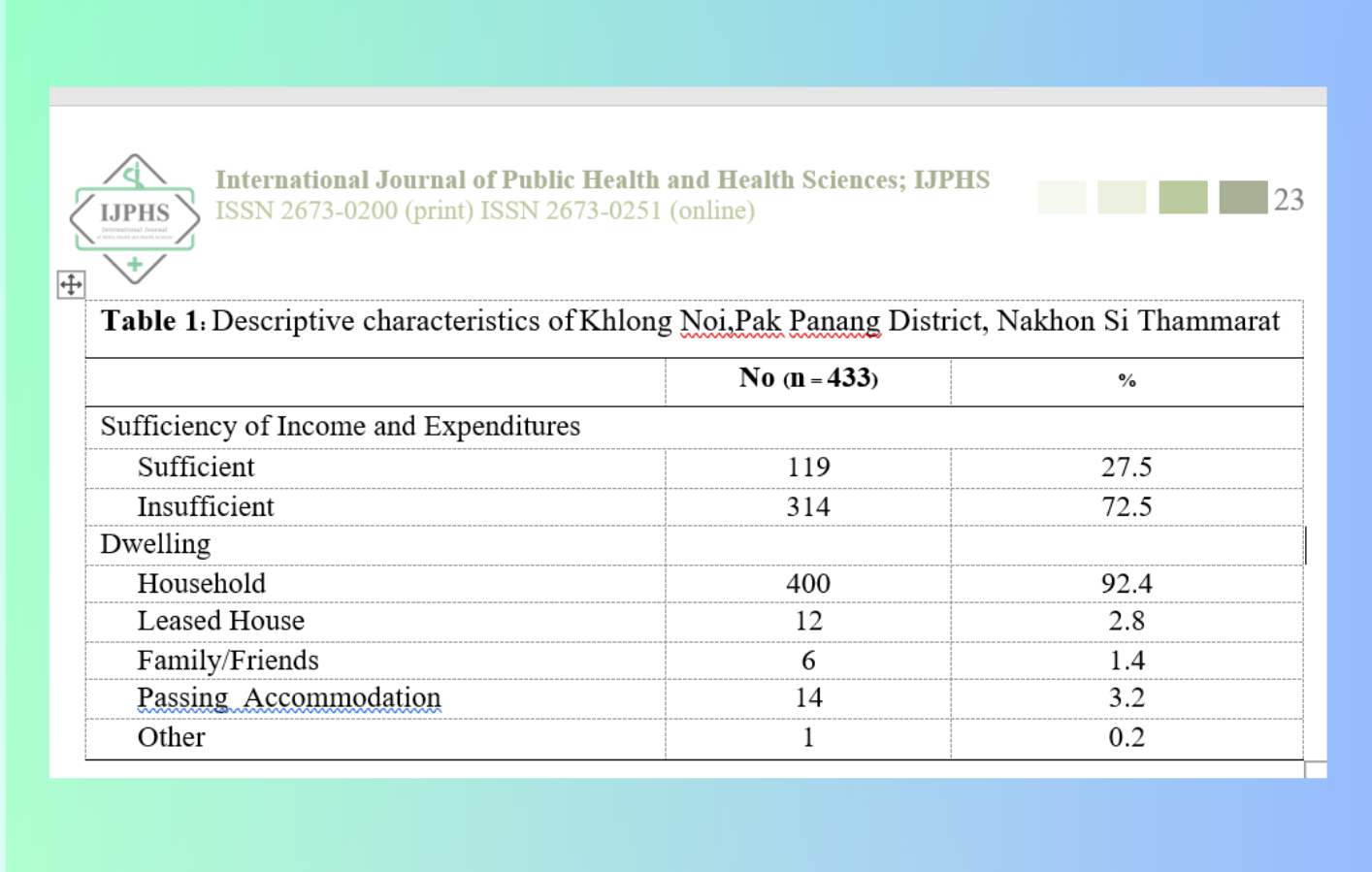Impact of Environmental Health and Quality of Life Indicators for Klongnoi Community, Pak Panang District, Southern Thailand
Keywords:
Environmental Health, Impact Factors, quality of lifeAbstract
Purpose: The purpose of this descriptive analytical study is to identify the factors that affect environmental health and health outcomes in relation to the standard of living in the Klongnoi Community Pak Panang district of Nakhon Si Thammarat.
Study Design: : 433 samples in total were questioned using questionnaires. Village Health Volunteers ("VHV") representatives performed a fecal examination and focus group advancement as part of an environmental health assessment to determine the prevalence of parasitic disease.
Results: 38% of them had an illness, and 44% of them had a chronic disease. The most common diseases that these individuals had were; Diabetes Mellitus (DM) and Hypertension (HT). They didn’t receive annual medical checkups, and 57% obtained government services for their illnesses for their right to medical attentionThe environmental health obstacles in the area were waste, rodents, insects, water supply and chemical pesticide being used. Most of them had an excellent quality of life, at 54%. From the sample group, 291 of them had a stool examination with a direct wet smear for parasite prevalence of disease. The data showed 1.72% of prevalence with Ascaris lumbricoid egg, strongyloides stercoralis rhabitiform lava; of which the same person was found in the equilibrium of parasites at a percentage of 2.41.
Conclusion: This study demonstrated that community involvement in environmental issues, particularly waste management, water supply, and flooding, were the primary problems that the community needed to address.
References
Gomach Juesathiansup.Vithichumchon (2002): A learning guide that makes the community
easy, fun and effective.1st edition of Nonthaburi: Health Systems Research Institute
(HSRI), 2002
Arporn Phaowattana, Surinthorn Klupakorn, Sunee lakumpan,Khewjai Amnartsatsea. Health
promotion and disease prevention in the community: application of concepts and
theories to 2nd Printing Klangnanawitthaya, 2012
Sujittra Yodjun, Janraja Suntayakorn, Narongsak Sornnu Pakorn Prajanban. (2011).
Effect of health belief program on self-protection behavior of pesticide use
among farmers. Journal of Nursing and Health., 5(2), 45-54.
Arpirom Chinno. (2010). Behavior in the use and protection of agricultural chemicals.
Karasin Province. Journal of Health Research and Development , 3(3), 49-57.
Keangkai Jumrenma,Sarut Sutthiarom,Sirjumnon Sirjunthana, Sanyanee Sirkacha,
Butsabong Manutmankong, Wiphada PlodKornburi and Wanaporn Wongnikong.(2009). Behavior and effects of insecticides and citrus mites on farmers in Fang and Mae Ai districts. Chiang Mai University, Department of Agriculture.
Supaporn Jaikaroon and Kanjana Nathapinthu. (2002). Pesticide Use in the Behavior of
Farmers Case Study: Ban Bueng Nuea, Bueng Niam Sub-district, Muang District,
Khon Kaen Graduate School , 6(3), 139-148.
Udom Chamaroek. (2007). The use of chili peppers: a case study of farmers in Khomarat
District, Ubon Ratchathani Province. Master's thesis, Social Sciences for
Development. Master of Arts Ubon Ratchathani Rajabhat University.
Ampon Jindawatthana,Surakeirt Archananupap and Suranee Pipatrodnokamol. (2008).
Health Promotion: Concepts, Principles, and Lessons from Thailand Mho Choa Bann. (2nd edition) Bangkok: [m.p.]
Chonnabot Bualuang. (2005). Development of preventive behaviors of pesticide users of
chemical spraying farmers Group 3 Ban Prasat, Tambon Paiyai, Ban Mai District
Master Thesis, Development Strategies Branch Master of Arts THEPSATRI Rajabhat University.
Health Center Nakhon Sri Thammarat. (2013). Summary and statistics of illness. Data
from http://www.nakhonsihealth.org/info/index.php?file=data_h_status.html
on Environmental Science, 6, 1-4. Pollution Control Department Report on
Thai State of pollution(in Thai) Ministry of Natural Resources and
Environment (2006),
Robert Bos Senior Scientist, World Health Organisation Environmental health impact
assessment: Principles and practice , Department of Public Health and Environment (http://www.wpro.who.int/NR/rdonlyres/19 CA5607-2 D28-4
E41-B8F9. 281FCE8003DA/0/EHIAPrinciplesandpracticeMrRobertBos.pdf)
Jha,M.K., Sondhi, O.A.K. & Pansare, M. (2003) Solid waste management – a case study.
Indian Journal of Environmental Protection, 23, 1153-11260.
Singhal, S. & Pande, S. (2001) Solid waste management: status and future direction.TERI
Information Monitor on Environmental Science, 6, 1-4.
Pollution Control Department (2006), Report on Thai State of pollution (in Thai) Ministry of
Natural resources and Environment

Downloads
Published
Issue
Section
License
Copyright (c) 2024 International Journal of Public Health and Health Sciences

This work is licensed under a Creative Commons Attribution-NonCommercial-NoDerivatives 4.0 International License.
If the manuscript is accepted for publication, copyright of the article shall be assigned to the IJPHS. After acceptance of a manuscript, the authors will be requested to complete a copyright transfer agreement form





